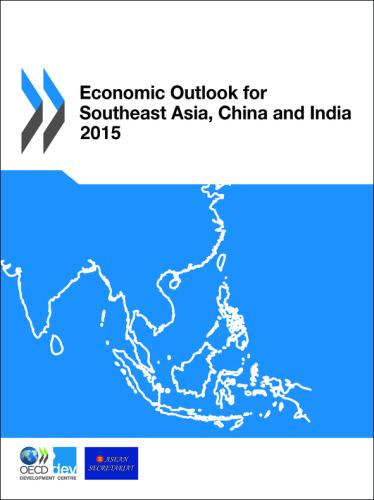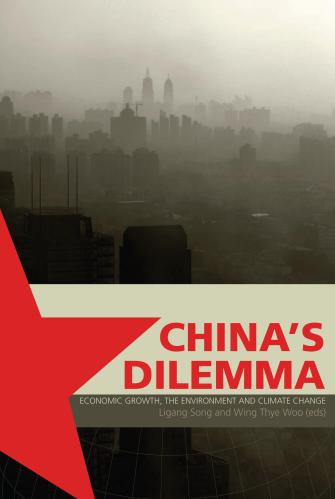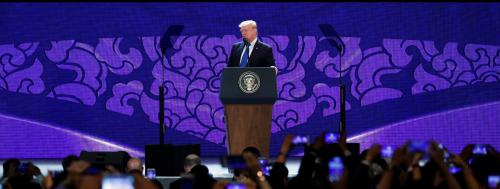On March 22 and 23, the Brookings Center for East Asia Policy Studies, John L. Thornton China Center, and The India Project—with the East Asia Institute (EAI), Japan Center for Economic Research (JCER), and S. Rajaratnam School of International Studies (RSIS)—hosted a conference on “U.S.-Asia relations in the new administration.” Experts from across the United States and Asia discussed economic and security dynamics of the Asia-Pacific, America’s future, economic integration, maritime security, North Korea, and more.
Convening the event, Stanley Roth, former assistant secretary of state for East Asian and Pacific affairs, observed that U.S. Asia policy used to enjoy strong bipartisan consensus. Now, he opined, “the absence of an integrated, comprehensive Asia strategy” and lack of Asia expertise within the Trump administration are resulting in poor policy outcomes.
Profound uncertainty was a central theme of the two days of presentations. Roth concluded:
“The most we can say about U.S.-Asia relations in the new administration is it’s a work in progress. Some relief that things haven’t happened, some relief about things that have happened, and lots of concerns about things that might happen. We just have to wait and see.”
Economic trends in Asia
David Dollar shared insights on China’s economic considerations. Noting Trump’s nationalist, anti-China rhetoric on the campaign trail, he said that it would be inaccurate to declare China a currency manipulator, as Trump pledged. Dollar surmised: “I wouldn’t be surprised if we had somewhat chilly economic relations between China and the U.S. over the next couple of years.”
Pitakdumrongkit said that Trump’s decision to withdraw the United States from the Trans-Pacific Partnership (TPP) trade deal represented an “opportunity loss” to take the lead in making the rules of trade in Asia. One likely result, she believes, may be that Southeast Asian countries lean toward China as Beijing seeks to fill this void by boosting investment in the region.
Yul Sohn, a dean at Yonsei University and director of Japan studies at the East Asia Institute, explained how South Korea faces both “China risk” and “Trump risk.” The country remains very export-oriented (roughly 85 percent of its gross domestic product is based on trade), and Beijing wields a great deal of influence over the Korean economy. The “Trump risk” pertains to protectionism, or what Sohn regards as “aggressive unilateralism”: attempts by the new administration to level the balance of trade with other nations and pry open foreign markets to advantage the United States.
Security in the Asia-Pacific
On security dynamics in the Asia-Pacific, Professor Suisheng (Sam) Zhao from the University of Denver’s Korbel School of International Studies said that the Chinese welcomed an American government that would refrain from imposing its values on their country. Reacting to Trump’s protectionist leaning, Zhao said: “China has to a certain extent positioned itself as a replacement to America’s global leadership and to the leader of globalization.”
Akihiko Tanaka, a professor at the University of Tokyo, voiced his surprise at the new administration’s anti-globalization position: “Mr. Trump’s depiction of America exploited by others is I think to us allies rather peculiar. Despite the dynamic change of economic growth and the remarkable rise of China, the United States is still by far the largest economy of the world.” As such, “we are relieved” that Washington so far appears to be adhering to “the basic strategy that the U.S. has traditionally followed in Asia” since the end of World War II. “Nevertheless,” he said, “we still have some concerns.”
Joseph Liow, a dean and professor at RSIS in Singapore, spoke on Southeast Asian perspectives. He doubted that Trump will sustain the Obama-era “pivot to Asia”: “Southeast Asians have been spoiled by the [Obama] pivot. The pivot has raised expectations which the Trump administration has no intention and no interest of meeting, let alone surpassing.” As Beijing seeks to fill the void left by U.S. retrenchment from Southeast Asia, Liow emphasized that regional nations do not want to be forced into a zero-sum choice between two sides.
India is likewise wrestling with competition between the United States and China, explained Tanvi Madan, director of The India Project at Brookings. “India does not want to see…a very conflictual U.S.-China relationship, either strategically or economically for that matter,” she said. “But it also doesn’t want to see a very close U.S.-China relationship, essentially a G-2.” The Indian government wants a sustained U.S. presence in the region to prevent “an Asia dominated by Beijing in which China can impose its will on the other countries in the region.”
Evan Medeiros, former director for Asia at the National Security Council for Barack Obama, linked economics and security in Asia, a relationship that he argued will define the regional order in years to come. Although international relations theory predicts otherwise, Medeiros observed that “East Asia is going through a very interesting period in which we’re simultaneously seeing more economic integration [and] more security competition and more security fragmentation.”
Medeiros identified four variables shaping this regional order: China, the coalescing security architecture, trade regimes, and the U.S. role in Asia. He pointed to “new geometries” emerging, as middle powers such as Australia, India, Japan, Malaysia, the Philippines, and Vietnam form deepening security ties. Despite “a lot of uncertainty and anxiety,” he noted, “the United States has a strong incumbent presence in Southeast Asia. That doesn’t vanish overnight.”
America’s Future
What about Trump’s worldviews and America’s future? Brookings senior fellow in Governance Studies William Galston remarked on Trump’s “marked preference for bilateralism” in trade and foreign relations, stemming from a conviction that “we will always prevail in a one-on-one negotiation.” Galston said the president views China as an adversary requiring a new seat of actions to confront the global challenges it presents. He stated, “U.S.-China relations have reached something of an inflection point.”
On the domestic front, E.J. Dionne, also a senior fellow in Governance Studies, pointed to two policy issues—health care reform and the House Intelligence Committee’s investigation into the Trump administration’s links to Russian interference in the election—that in his view represent the greatest tests for U.S. governance. Ted Gayer, vice president and director of Economic Studies, showed that the unemployment rate today is lower than it was before the recession, with 77 consecutive months of job growth since the economic slowdown.

On the view from Europe, Brookings Senior Fellow Constanze Stelzenmüller indicated that Europeans are most concerned by the Trump administration’s “open hostility” toward the European Union at a time when it is riven by internal divisions. Nevertheless, she maintained, Europeans remain convinced of the need for support from the United States in facing transnational issues.
Economic integration
Claude Barfield of the American Enterprise Institute discussed the Trump administration’s economic statecraft. He stated that the U.S. withdrawal from the TPP has a direct impact on the American economy and competitiveness, and that the Regional Comprehensive Economic Partnership, which includes seven members of the TPP and China, among others, is not a good substitute. Nonetheless, he argued, it would be better for the Trump administration to pursue bilateral trade agreements than nothing at all.
Kazumasa Iwata observed that the new administration’s priority is to defend national (economic) sovereignty over trade policy, rather than upholding the liberal international order. The risk of these policies, he noted, is that such unilateralism could trigger tit-for-tat protectionism on the part of other countries.
International order
In a keynote address, Michael Green, senior vice president for Asia at the Center for Strategic & International Studies (CSIS) and George W. Bush’s former national security adviser for Asia emphasized the importance of structure, order, and institutions in constraining individual agency within the international system.
While there is something to be said for being unpredictable, Green acknowledged, this is not a sustainable position in the long run. He underscored the moderating influence that Congress, particularly younger Republican legislators, would likely have on Asia policy, an area of strong bipartisan consensus.
The persistent North Korea threat
On North Korea, Chaesung Chun, chair of the Asia Security Research Center at the East Asia Institute, noted that Beijing’s concerns about the risk of sudden regime collapse in Pyongyang and a strengthened U.S.-South Korea alliance make cooperation with China necessary to deter North Korea.
Brookings Senior Fellow Jonathan Pollack remarked that North Korea remains our “most enduring adversary” in the world. It has the most widely despised political system in the world, but many people treat it as a cartoon. North Korea is dangerous and requires serious thinking, Pollack warned.
Noting the new administration’s shifting attitudes and approach toward North Korea, Wu Xinbo, director of the Center for American Studies at Fudan University, urged a strategy of diplomacy and enhanced deterrence, and he highlighted the need for U.S.-China cooperation.
Maritime Asia
The final panel focused on maritime security in Asia. Bonnie Glaser, a senior adviser for Asia at CSIS, laid the blame squarely with China for instability in the South China Sea. However, she also acknowledged Chinese contributions to maritime stability: agreements on joint development of fisheries, the 2002 China-ASEAN Declaration on the Conduct of Parties in the South China Sea, and the Code of Unplanned Encounters at Sea (CUES).
Wu Xinbo argued that Sino-Japanese maritime disputes have stabilized in recent years and urged all sides to refrain from conducting military operations in disputed waters. Sinderpal Singh, a senior fellow at RSIS, discussed of the larger Indo-Pacific strategic space. He noted that “ASEAN can punch above its weight” and that as a great power, Indonesia has a key role in maintaining maritime stability, given its location at the nexus of the Indian Ocean and South China Sea.
Sheila Smith, a senior fellow at the Council on Foreign Relations, called attention to the risk of tensions in the East China Sea as China and Japan increasingly confront one another’s maritime forces in disputed waters. She added that Japan’s expanding naval capabilities, coordination with the United States, and assistance to Southeast Asian countries’ coast guards stem from Japanese security concerns and a desire to avoid conflict.
Brookings senior fellow and director of the Center for East Asia Policy Studies Richard Bush concluded by noting that issues surrounding North Korea and bilateral trade were likely to take precedence at the Trump-Xi meeting in Mar-a-Lago. However, Bush remarked, if you don’t tend to issues on the backburner, they have a way of shifting to the forefront in times of crises.









Commentary
Forecasting U.S.-Asia relations under Trump
April 10, 2017